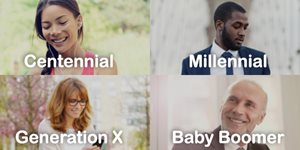How Each Generation Responds To Marketing Communications
It is no secret that there is no such thing as a one-size-fits-all approach to marketing.  Reaching and engaging each generation requires different marketing communication efforts as each age group’s shopping habits significantly differ from one another. There is nothing more natural than this as each generation has grown up with different technological advancements in different social and political environments. The key for marketers, is to understand the nuances so they can create brand awareness and ultimately, cultivate a brand loyalty.
Reaching and engaging each generation requires different marketing communication efforts as each age group’s shopping habits significantly differ from one another. There is nothing more natural than this as each generation has grown up with different technological advancements in different social and political environments. The key for marketers, is to understand the nuances so they can create brand awareness and ultimately, cultivate a brand loyalty.
To navigate marketers in these daunting waters, Yes Lifecycle Marketing conducted a survey of more than 1,000 consumers on their shopping habits by generation. The research that covers Centennials to Baby Boomers and everyone in between found that millennials are more likely than any generation to have made a purchase on Amazon in the past month (79 percent), touting its Prime benefits as the reason for doing so. Generation Z, however, is more likely to sit out, with 31 percent reporting they shop at non-Amazon retailers because they enjoy the in-store shopping experience, more than any other generation. It is also worth noting that the report covers many more eyebrow-raising findings on shopping behaviors by generation.
I am sure, as a marketer, you have read this marketing mantra a billion if not a trillion times: “target the right audience, at the right time with the right message across the right channels.” This article will not discuss why you should do it, yet it will show you how to do it by incorporating some of the survey findings.
Centennials (Under the Age of 21)
While the report describes them as digital natives, it also states that this particular generation  doesn’t engage in the traditional customer service channels (such as phone or email), but they still expect personalized interactions with brands that understand their needs. Centennials do not hunt for bargains, yet half of Centennials (50 percent) based their last purchase decision on product quality, more than any other generation.
doesn’t engage in the traditional customer service channels (such as phone or email), but they still expect personalized interactions with brands that understand their needs. Centennials do not hunt for bargains, yet half of Centennials (50 percent) based their last purchase decision on product quality, more than any other generation.
If Centennials are the right audience for you, then the next step is to find out the right channel and the right messaging to engage them with. According to the survey results, more than 80 percent of Centennials value social media when it comes to making a purchase decision. To be more specific, 44 percent of Centennials find Instagram important, and 21 percent find Snapchat important in their purchase decisions. Keeping in mind that Centennials are largely influenced by content, the right social message should be personalized as well as valuable. In other words, you should promote quality and authenticity over price. If your messaging is focused on pricing, then, at least, you should provide seamless cross-channel experience with personalized offers that can be easily utilized via any channel of choice.
According to the survey, Centennials find email influential less than all other generations but still, the rate is not too low, as 46 percent find email important in their decision-making process, and 60 percent have made a purchase from email in the past three months. To me, this figure tells that email marketing is still on the table as long as you know what message resonates with them, which leads me to the next interesting findings from the survey. 85 percent of Centennials said that they would make more email-driven purchases than other generations if the brand offers an easy online/mobile experience. In addition to the right messaging, 45 percent of this generation is influenced by personalized content while 53 percent is affected by product recommendations.
Now that you know what to include your messaging, there is only one question left: when is the best time to engage with this hard-to-reach generation via email? The survey suggests that Centennials check their emails more than other generations while on the go, including while commuting (6 percent) and in situations where they want to pass the time, such as waiting in line (14 percent). If a brand that targets this specific age group wants to send an email, it would be wise to take advantage of location-based advertising and marketing technologies as it is one of the best methods to tap into consumer obsession with mobile devices to trigger local offline conversions through the power of location data.
For more findings on Centennials, you can view the report.
Millennials (ages 22 to 37)
In contrast to the common dichotomy saying Millennials are fickle, the report describes them  as brand loyalists, as Millennials demonstrate the most brand loyalty of all the generations based on the survey findings. The study also suggests that as long as brands keep their promises and deliver personalized experiences, Millennials are the most open to the marketing messages.
as brand loyalists, as Millennials demonstrate the most brand loyalty of all the generations based on the survey findings. The study also suggests that as long as brands keep their promises and deliver personalized experiences, Millennials are the most open to the marketing messages.
If Millennials are the right audience for you, then your next step is to find out the right channel to engage with them. First off, brands who are after Millennials should make sure all channels are aligned and consistent. However, the findings suggest that this generation values email more than any other generation as 67 percent say a brand’s email is important for their decision to purchase, and in the past three months, 83 percent have made a purchase as a result of an email. Furthermore, 47 percent of Millennials have made three or more purchases after clicking on an email, which represents twice as many as Centennials.
When it comes to the messaging, Millennials value personalizing brand interactions more than any other generation. To be more specific, 49 percent of this generation is influenced by personalized content while 56 percent is affected by product recommendations. Additional to the right messaging, Millennials make email purchases based on loyalty more than any other group.
Even though it is not surprising that social media is very influential among the youngest two generations, for the specifics, the study found that Millennials prefer Facebook more than any other generation. Therefore, Yes Marketing recommends brands seamlessly integrating Facebook and email marketing as they are the favorite channels among Millennials.
Another interesting finding is that with a staggering 79 percent of Millennial shoppers having made a purchase from Amazon in the past 30 days, that makes them more likely than any other generation to have made a purchase on Amazon. The reason why Millennials do so is Amazon Prime benefits which again shows their affinity for brand loyalty programs.
For more findings on Millennials, you can view the report.
Generation X (ages 38 to 52)
The report describes them as bargain hunters as these shoppers are most likely to be  influenced by price and care less about brand loyalty than other generations based on the findings. Their motivations are price (55 percent), followed by quality (45 percent) and convenience (23 percent).
influenced by price and care less about brand loyalty than other generations based on the findings. Their motivations are price (55 percent), followed by quality (45 percent) and convenience (23 percent).
If Generation X is the right audience for you, you can engage with them via email as they value email almost as much as Millennials. 77 percent of Generation X shoppers have made recent purchases as a result of an email. This age group is influenced more by the ease of doing business than personalized brand interactions.
Even though Generation X claims that they are generally not influenced by social media, 58 percent of Generation X also says social media influences their shopping. Use of Snapchat is almost nonexistent among Generation X shoppers. As mentioned earlier, 79 percent of Millennials have made a purchase from Amazon in the past 30 days, whereas this trend is followed by Generation X with 69 percent.
The right messaging for this generation should include good deals, such as quality products at good price, and easy paths to purchase. Similar to the other age groups, the most popular times for Generation X consumers to check their email for brand messages are at home in the morning (32 percent) and evening (31 percent), but a quarter of all shoppers keep coming back as a result of relevant content.
For more findings on Generation X, you can view the report.
Baby Boomers (ages 53 to 71)
The report describes them as price-savvy shoppers due to their high tendency in shopping with brands that offer wide selections at discounted prices. Their motivations behind making a purchase are price (62 percent), convenience (30 percent) and product variety (21 percent).
brands that offer wide selections at discounted prices. Their motivations behind making a purchase are price (62 percent), convenience (30 percent) and product variety (21 percent).
According to the report, Baby Boomers and Generation X find email equally important to their shopping journeys. However, the difference is that Baby Boomers make fewer email purchases than other generations as 62 percent of this age group have made recent purchases as a result of an email.
Baby Boomers have less interest in social media for shopping purposes than other generations. 54 percent of Baby Boomers, on the other hand, have made a purchase from Amazon in the past 30 days. Baby Boomers, in contrast to Millennials, are the most likely to value Amazon’s convenience and product selection.
When it comes to content, Baby Boomers are not interested in personalized experience as their primary focus is pricing and wide product selection. Therefore, when asked what types of email content are most influential, Baby Boomers expressed less interest in content overall than any other generation. 32 percent said that content does not influence their purchase decisions whatsoever. As far as timing goes, the best time of the year is from September to November.
For more findings on Baby Boomers, you can view the report.
My POV
Why Millennials value email more than any other generation makes sense as this age group has utilized email as a primary engagement channel since they were writing their school papers. With the same logic, the finding on Centennials’ high tendency to use social media as a primary channel also seems to be on point. What came as surprise though was Millennials’ affinity for brand loyalty programs.
Additionally, even though personalizing brand interactions resonates more with younger generations, considering ever-increasing consumer expectations, all marketing efforts should be personalized on some level, regardless of audience.
As far as social media channels go, one of the most interesting findings was Pinterest plays a relatively equal role across generations. So for those who are not sure about their audience, Pinterest seems to be a safe road to go down, at least for a modest social media success.

Venus Tamturk
Venus is the Media Reporter for CMS-Connected, with one of her tasks to write thorough articles by creating the most up-to-date and engaging content using B2B digital marketing. She enjoys increasing brand equity and conversion through the strategic use of social media channels and integrated media marketing plans.